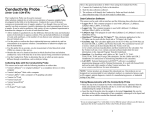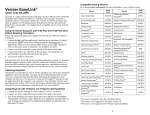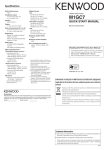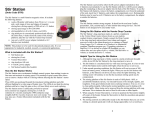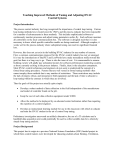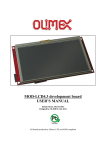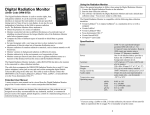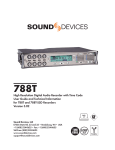Download Vernier Dynamics System - Vernier Software & Technology
Transcript
Note: This product is to be used for educational purposes only. It is not appropriate for industrial, medical, research, or commercial applications. Vernier Dynamics System (Order Code VDS) The Vernier Dynamics System consists of a 1.2 m track, two carts, and related accessories. The system is designed for use in physics and physical science courses for motion and energy experiments. An optional Optics Expansion Kit (Order code OEK) converts the track to an optics bench. An optional Track to Track Coupler (Order code T2T-VDS) joins two tracks together. Some typical experiments done with the system include • • • • Motion under zero acceleration Motion under constant acceleration with the ramp inclined Inelastic collisions using the included Velcro tabs Elastic collisions using the included magnetic bumpers The Vernier Dynamics System is designed for use with many data-collection tools, such as the Vernier Motion Detector, Go! Motion, Vernier Photogates, and the Vernier LabPro® interface. Appropriate software includes Logger Pro® for computers, LabQuest App for LabQuest®, DataMate and Vernier EasyData® for calculators, and Data Pro for Palm® handhelds. What is included with the Vernier Dynamics System? The Vernier Dynamics System is shipped in two boxes. The long box contains the track and feet, while the other box contains the remaining parts. Long box marked TRACK Track Double foot stand (2) Box marked VDS-KIT Standard Cart with two magnets and foam plugs for included end caps and Velcro™ tabs Plunger Cart with two magnets and foam plugs for included end caps, Velcro tabs Rod clamp Adjustable end stop with two magnets and foam plugs for included end caps Photogate brackets (two) Motion Detector bracket Mass Accessory mounting hardware Hex wrench Carts The Vernier Dynamics Carts are supplied with magnets and Velcro tabs. You may choose to install either or both on your carts. Since the magnets may interfere with certain experiments using force sensors on the carts, only install the magnets if you need them. The magnets are useful in studying collisions with the magnets positioned so that they are the same polarity on both sides and on both carts. This way the carts will repel one another, and you can arrange a collision in which the carts never actually touch. The collision will be very nearly elastic, unlike a collision using a spring or any kind of contact. To install magnets so that carts will repel one another, as well as the adjustable end stop, use the following procedure. 1. Remove the teardrop from the cart end or the end stop. 2. Insert the silver magnet (supplied with the cart) into the teardrop, oriented so that the outside of the teardrop will attract the south-pointing end of a compass needle. 3. Insert a foam plug (supplied with the cart) into the teardrop. 4. Reinsert the tear drop into the cart end or the end stop, and fasten the screw. If you like, test by holding the compass near the cart or stop, in the same position as an approaching cart, and verify that the south-pointing end of the compass is attracted to the cart. Carts come with magnets, foam plugs, teardrop inserts, and a hex key to remove and replace the screw holding the teardrop to the cart end. A magnetic compass is not included. The magnets can be removed at any time by reversing this process. Store the magnets away from computers. To study totally inelastic collisions, place Velcro tabs on top of the teardrop-shaped plugs. Looking at the end of the cart, place a hook pad on the left-hand plug, and a pile pad on the right-hand side. Center the pad on the round part of the plug. This way any cart with Velcro pads will stick to any other. Velcro-equipped carts will stick together, creating a totally inelastic collision. One cart includes a spring-loaded plunger for collisions. To use the plunger, simultaneously press the horizontal button above the plunger and press the plunger in until it locks. To release, press on the pin from the top of the cart. The plunger force can be adjusted. To adjust the plunger release force, rotate the plunger while it is extended. 2 Both the plunger and simple carts have a mass of 500 g. Adding accessories will change the mass. Adjustable End Stop Photogate Bracket The adjustable end stop slides into the end of the track. Adjust the position as desired. Insert magnets in the end stop if desired. Photogate brackets are attached to the side of the track. With the nut loosely on the T-handled bolt, slide the nut into the side channel of the track. Attach the photogate using the supplied wing bolt in the long slot. Adjust the gate height so the beam intercepts the desired portion of the target. Rod Clamp The rod clamp is used to support the track with a user-supplied ring stand. Insert the rod clamp nut into the side of the track. Adjust the height as desired. Motion Detector Bracket Any Vernier Motion Detector with a hinged head can be attached to the supplied Motion Detector Bracket. The Motion Detector Bracket has a pin to locate the Motion Detector on the bracket. There is a knob, nut and bolt to attach the bracket to the track underside, and a threaded hole at the end near the pin. To assemble, place the Motion Detector with the back end over the pin of the bracket. Insert the screw through the slot into the threaded insert on the detector with the hinge toward the track, and tighten. Insert the bracket into the slot in the underside of the track as shown in the photo. When the Motion Detector is not attached to the bracket, its mounting screw can be stored in the threaded hole near the pin. Mounting Hardware The supplied mounting hardware is used to attach devices to the cart, such as a force sensor, accelerometer, or mass. To attach a Wireless Dynamics Sensor System (WDSS) use the hardware supplied with that device. The hex-head bolts may be attached to any point along the slots in the cart, but the head must be inserted in the flare region of the slots. Tighten the threaded barrels on the bolts. Newer Vernier Motion Detectors (green or black case with adjustable sensitivity) can be placed so that the sensor is 15 cm from the end of the track. The carts can then be detected properly all the way to the end. The track mode is appropriate for the dynamics system. Double Foot Stand The double foot stand slides into the end of the track, with the nut in the center slot of the track underside. Adjust the height as desired. Install the stands before attaching the motion detector bracket. 3 4 The Additional Mass (MASS) The Low-g Accelerometer (LGA) The 500 g mass is used to double the mass of the cart. 1. Insert the hex head of the #10-32 x 1-3/4” screw into either of the side slots on the cart from the flared end. 2. Fit the mass over the screw and position the mass and screw as required on the cart. 3. Screw the small barrel onto the projecting end of the #10-32 x 1-3/4” screw and tighten to secure the mass. The LGA is attached to one of the side slots of the cart using the #10-32 x 3/8” hex head screw and the small threaded barrel. The LGA is attached on one side only to maintain the correct orientation of the sensor. 1. Insert the #10-32 x 3/8” hex head screw into one of the mounting holes of the LGA from the bottom and screw on the barrel a few turns, leaving at least half of the screw threads exposed for fitting into the slot. 2. Use the arrow printed on the sensor to decide which of the cart side slots to use so that the sensor is oriented in the desired direction. 3. Slide the head of the screw into the chosen slot from the flared end, position the sensor as required, and tighten the small barrel to secure it to the cart. The following examples show various sensors attached to the Vernier Dynamics Cart. Sensors are not included with the Vernier Dynamics System. Attach the Dual-Range Force Sensor (DFS) 1. Insert the hex head of the screw on the bottom of the post into the center slot of the cart at the flare. The flats of the hex head should be parallel to the slot and the washer should be above the slot to avoid marring the cart with the metal post. 2, Slide the post to the desired position on the cart and lightly tighten in place with the knurled end of the post. 3. Place the DFS on the cart with the post through its central hole. Reposition the post if necessary, and tighten. Tighten the plastic screw on the end of the sensor to secure the DFS in place. 5 DFS and LGA in Combination The DFS (Dual-Range Force Sensor) and LGA (Low-g Accelerometer) can be combined using the same procedures. As long as the DFS is positioned so that the attachment to be used is facing in the required direction, the order of attachment is not critical. 6 Wireless Dynamics Sensor System MASS and DFS Attach the DFS first, since the plastic screw on the DFS becomes inaccessible when the MASS is attached. The DFS must be attached at the opposite end of the cart from the slot flares if you want to be able to remove the mass without removing the DFS. Mounting on a Vernier Dynamics Cart For connection to a Vernier Dynamics cart use a 5/8" × 10-24 binding barrel and a hex-head bolt (1" × 10-24). First place the bolt head in the middle slot of the top of the Vernier dynamics cart. Then lower the WDSS on top of the cart and insert the binding barrel in the large hole of the WDSS. The bolt threads into the binding barrel. Tighten the binding barrel. The process is shown in the series of photos below: MASS and LGA Hints for Using VDS For this combination, the order of attachment is not critical: • • • • • • MASS, DFS, and LGA This is a similar case to the MASS and DFS, where the DFS must be attached first. There is sufficient room on the new MASS bolt to piggyback the LGA on top of the mass before attaching the small barrel. • • • 7 Don’t install the magnets unless you know you want to use them. They will interfere if you perform an experiment with a force sensor riding on the cart, since the force sensor will then not read the total force acting on the cart. The magnets can be hard to pull apart if they stick together before installation; slide them across one another to separate. The conventional arrangement for magnets to have the cart ends attract the S end of a compass needle. The key thing is that all magnets repel, so if you use the opposite convention everywhere, no harm is done. The magnets are designed for fairly gentle collisions. If the cart is moving too quickly, the magnetic forces may cause the cart to jump off the track to the side. If this happens, use a lower initial velocity for the cart. Keep the track clean; if it is very dusty the carts will not roll smoothly. Use lower speeds and lower inclines than you might initially choose; the physics is the same and students will have more time to observe what is happening. Attach the track feet, sliding at least one in about 30 cm before inserting the Motion Detector bracket. Study the Motion Detector bracket photo carefully and note that the bracket is attached to the underside of the track. A common error is to attach the bracket to the top slot on the track. Some Dual Range Force Sensors come with a plastic bolt that is too long to allow simultaneous attachment of the DFS with a MASS. If your bolt is long, use a wire cutter to remove a few threads at a time. 8 Sample Experiment Suggested Accessories An example of a typical experiment done with the Vernier Dynamics system is a two cart, inelastic collision for studying momentum conservation. This experiment takes two motion detectors, since both carts are in motion. A Motion Detector is placed just a few centimeters from each end. For this experiment, in Logger Pro the direction of one detector was reversed, and then both detectors are zeroed with the carts stuck together near the middle of the track. This places the origin of the common coordinate system near the middle, and the two readings will then be the same when the carts are in contact. The Vernier carts had the Velcro end caps in place to create a completely inelastic collision. After starting data collection, the carts were rolled toward one another, with one cart moving a bit faster than the other. On collision, the Velcro held the carts together as they roll on. Note several features of the graph: • Before the collision, the carts are moving with constant velocities of opposite sign, since they are moving toward one another. • The carts move as a unit after the collision with a common, constant velocity. Both carts are very nearly 0.500 kg; the total momentum before the collision is then 0.184 kg m/s. Afterward, the momentum is 0.183 kg m/s. Dynamics Track Adapter (DTA-DFS). The DTA is used to attach a Dual Range Force Sensor to a track in several different positions. Magnetic bumpers for the DFS are included. Optics Expansion Kit (OEK). The Vernier Optics Expansion Kit extends the Vernier Dynamics System for use in optics experiments. Color Mixer (CM-OEK). The Vernier Color Mixer Kit consists of a three-color LED illuminator with power supply, a lens, and a double-sided screen. Experiments in additive and subtractive color mixing can be easily and conveniently carried out using this kit. The intensity of the red, blue and green LEDs can be smoothly controlled from the light source. Additional Track (TRACK). Add another track to your system. Track-to-Track Coupler (T2T-VDS). The Track-toTrack Coupler rigidly connects two tracks for larger experiments and demonstrations. Ultra Pulley (SPA). The pulley can be attached to the end of a track using the Pulley Bracket to make a half-Atwood machine. Pulley Bracket (PB-SPA). The pulley bracket allows easy attachment of an Ultra Pulley to the end of a Vernier track. Compatible with a photogate bracket for measuring motion using the pulley. 9 10 The Cart Friction Pad (PAD-VDS) is a variable friction mechanism for use with the Vernier Standard Cart and Plunger Cart. It can be used on any flat surface or, for best results, with the Vernier Dynamics System to study the effects of friction. The two-speed Dynamics Cart Fan (FAN-VDS) magnetically attaches to the Vernier Standard Cart and Plunger Cart. It can be used on any flat surface or, for best results, with the Vernier Dynamics System to study motion, force, and momentum Warranty Vernier warrants this product to be free from defects in materials and workmanship for a period of five years from the date of shipment to the customer. This warranty does not cover damage to the product caused by abuse or improper use. Vernier Software & Technology 13979 S.W. Millikan Way • Beaverton, OR 97005-2886 Toll Free (888) 837-6437 • (503) 277-2299 • FAX (503) 277-2440 [email protected] • www.vernier.com Rev. 5/07/10 Logger Pro, Logger Lite, Vernier LabPro, Go! Link, Vernier EasyLink and other marks shown are our registered trademarks in the United States. CBL 2, TI-GRAPH LINK, and TI Connect are trademarks of Texas Instruments. All other marks not owned by us that appear herein are the property of their respective owners, who may or may not be affiliated with, connected to, or sponsored by us. Printed on recycled paper. 11 12







